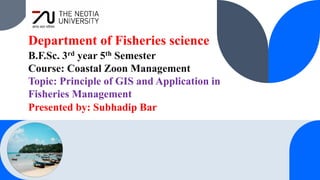
Principle of GIS and Application in Fisheries Management .pptx
- 1. Department of Fisheries science B.F.Sc. 3rd year 5th Semester Course: Coastal Zoon Management Topic: Principle of GIS and Application in Fisheries Management Presented by: Subhadip Bar
- 2. Content Introduction Key Principle of GIS Major Steps in GIS Effectivity in Fisheries Management Disadvantage of GIS in Fisheries Management 2
- 3. Introduction 3 Geographic Information Systems (GIS) play a crucial role in fisheries management by providing tools and techniques to collect, analyse, and visualize spatial data related to fishery resources. The principles of GIS involve the use of geographic data to better understand and manage resources, and this can be applied effectively in fisheries management Here are some specific applications of GIS in fisheries management: Data Integration Fishery Planning and Site Selection Stock Assessment Resource Assessment Environmental Monitoring Risk Assessment Habitat Analysis Effort and Catch Analysis Ecosystem-Based Management Research and Modelling
- 4. Key Principles 4 The key principles of Geographic Information Systems (GIS) into four important points, here they are: Spatial Data Management: GIS is centred around the collection, storage, and efficient management of spatial data, which includes information tied to geographic locations. Spatial Analysis: GIS allows for the analysis of spatial relationships and patterns within data. Like buffering, overlay, proximity analysis, and modelling.
- 5. Key Principles 5 Effective Visualization: GIS principles emphasize the importance of creating clear and informative maps and visualizations. Proper cartographic design, data representation, and data visualization. Data Quality and Ethics: Ensuring the accuracy, completeness, and reliability of data is a core GIS principle. Additionally, ethical considerations, including responsible data collection and use, respecting privacy, and minimizing biases in spatial analysis, are vital aspects of GIS practice.
- 6. Major Steps 6 Researchers, technicians, analysts that ask questions, choose, collect, analyze the data, and interpret results. Spatial Data (spatially located) Vector Data Raster Data Image Data Attribute Data (non-spatial) The computer systems, technical equipment, and networks where GIS operates. Provides the functions needed to store, analyze, and display geographic information. Guidelines, specs, procedure, and standards for analyzing and applying GIS.
- 7. 7 1. Data Integration: GIS principles emphasize the integration of various types of spatial data relevant to fisheries, including biological data (e.g., fish populations), environmental data (e.g., oceanography, water quality), and socioeconomic data (e.g., fishing activities, market demand). The integration of these datasets enables a comprehensive understanding of the fisheries ecosystem. 2. Fishery Planning and Site Selection: GIS helps in identifying suitable locations for fishing activities based on factors like water depth, temperature, salinity, and proximity to fish habitats. It aids in optimizing fishing efforts while minimizing environmental impact. Effectively in Fisheries Management
- 8. 8 3. Stock Assessment: GIS is used to integrate data on fish catch, environmental conditions, and habitat characteristics. This enables fisheries managers to assess the health and abundance of fish stocks, which is essential for setting sustainable catch limits. 4. Environmental Monitoring: GIS can be used to monitor environmental factors that affect fisheries, such as water temperature, salinity, and ocean currents. This information helps in understanding the impact of climate change and other environmental changes on fish habitats. 5. Habitat Analysis: GIS tools allow for the identification and analysis of critical fish habitats, such as spawning areas, nurseries, and feeding grounds. This information is vital for implementing conservation measures to protect these areas.
- 9. 9 6. Risk Assessment: GIS can be employed to identify areas prone to overfishing or habitat destruction. By analysing historical data and modelling future scenarios, fisheries managers can assess the risks associated with different management strategies. 7. Research and Modeling: GIS facilitates the development of models for predicting fish populations, assessing the effects of management strategies, and conducting scenario analyses. These models are crucial for evidence-based decision-making.
- 10. Disadvantages of GIS in Fisheries Sector 10 While Geographic Information Systems (GIS) offer numerous advantages in the fisheries sector. Like: Cost and Resource Intensiveness: Implementing and maintaining a GIS system can be expensive. It requires investment in hardware, software, training, and ongoing maintenance. Technical Expertise Required: Effective use of GIS demands specialized knowledge and skills. Fisheries professionals need training to operate GIS software, interpret spatial data, and perform spatial analyses
- 11. 11 Ethical and Privacy Concerns: GIS applications can involve sensitive information, such as the locations of fishing operations, which may need to be protected for security or privacy reasons. Managing and protecting this information ethically can be challenging. Limited Accessibility: In remote or less developed areas, access to GIS technology and expertise may be limited. This can create disparities in the capacity to utilize GIS for fisheries management.